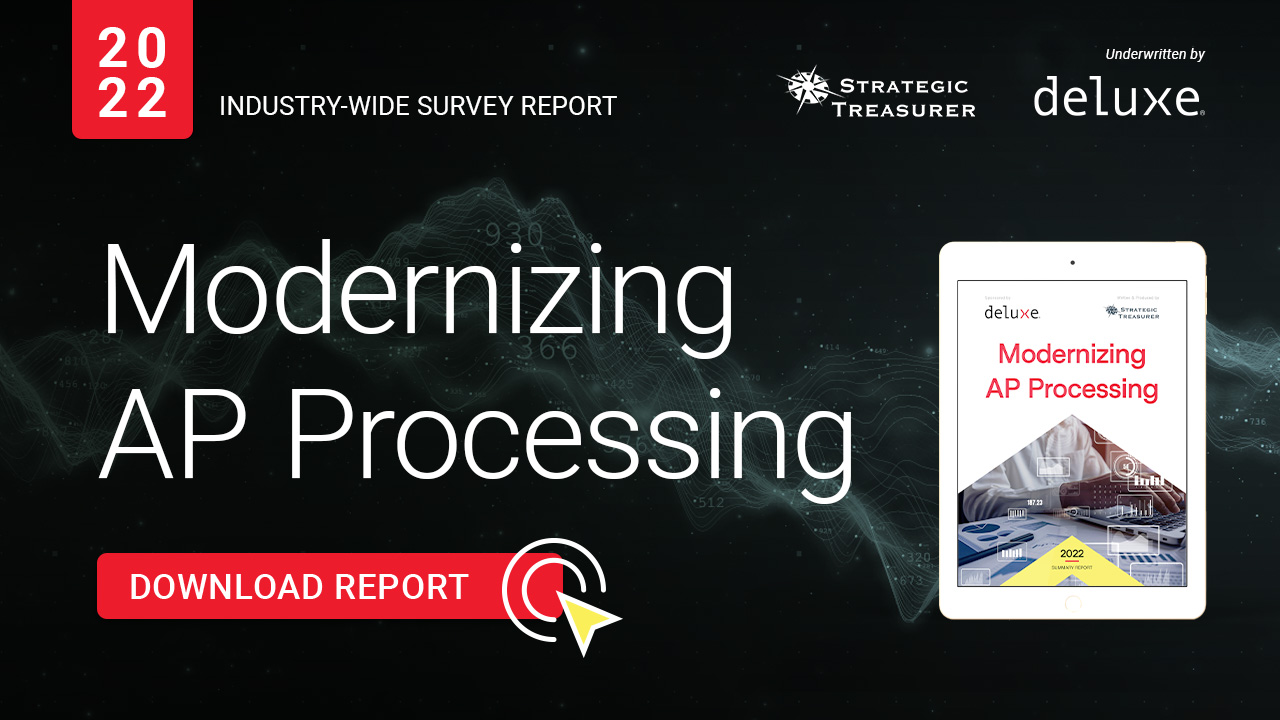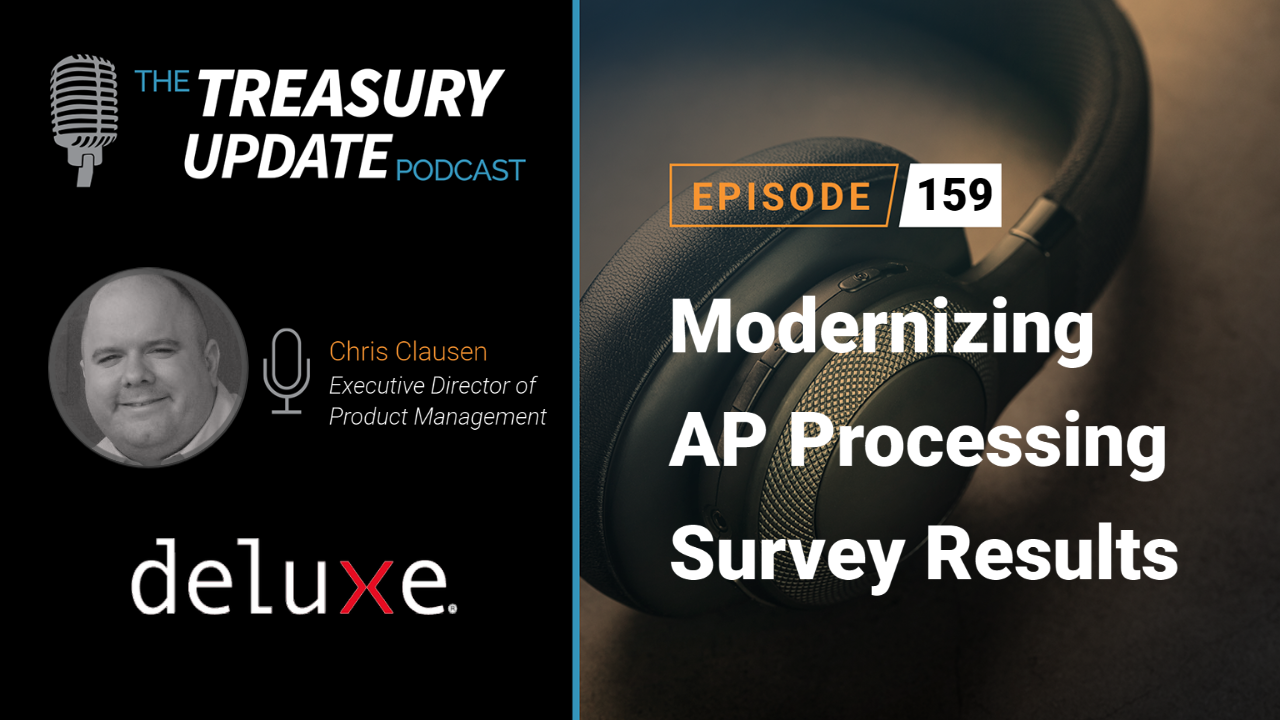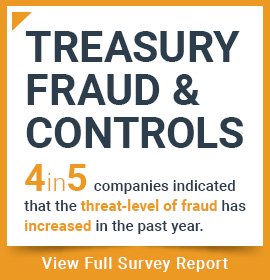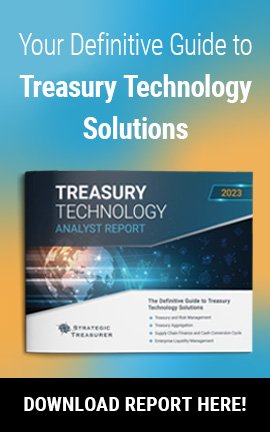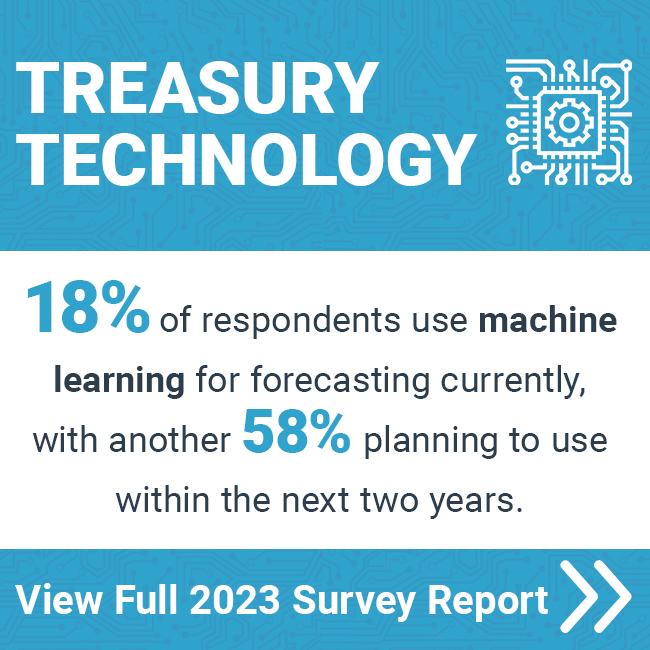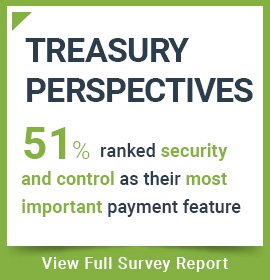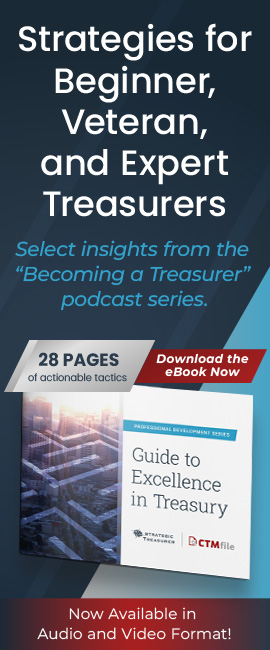
Episode 209
The Power of Networks
Host:
Craig Jeffery, Strategic Treasurer


Speaker:
Chris Clausen, Deluxe


Episode Transcription - Episode 209: The Power of Networks
00:00:03 Announcer
Strategic Treasurer currently has two live surveys open through July of 2022. They’re on different aspects of payments. Virtual card solution survey with MasterCard is a quick 10 minute survey on challenges, expectations, and value drivers of virtual card programs. Global payments with Corpay is one of our longstanding premier surveys. Researching FX cross-border transfers and new payment technologies. Please visit strategictreasure.com/surveys to learn more. Welcome to the Treasury Update Podcast presented by Strategic Treasurer. Your source for interesting Treasury news, analysis, and insights in your car, at the gym, or wherever you decide to tune in.
00:00:57 Craig Jeffery
Welcome to the Treasury Update Podcast. This is Craig Jeffrey and I’m here with Chris Clausen from Deluxe. Today’s topic is the power of networks, and there’s certainly a lot of discussion about where is there value in networks. And our discussion will center a little bit more on the accounts receivable accounts payable view of networks. Chris, Welcome back to the Treasury Update Broadcast.
00:01:20 Chris Clausen
Thanks Craig for having me back. I appreciate it. Always enjoyable talking with you.
00:01:25 Craig Jeffery
I don’t know if we’ve been on more podcasts or webinars together, but we talk a lot. Chris, wanted to get your view on the power of network, so maybe we should begin by the concept of, you know, talk about the concept of, what are networks? Where’s the value in networks? And we’re going to be thinking about this in terms of payables and receivables. You know, what’s the value of a network? How do you optimize your user network? So maybe we can begin with where do you see the value of networks generally?
00:01:59 Chris Clausen
Well, when I look at the value of the network, and where it fits in, particularly in a payables and receivable scenario, is it’s really a group of business entities that or potentially consumer entities that have a general understanding of a common set of rules. There’s a known set of value props that those entities can experience by participating in the network, and there’s a familiarity with the methods and the processes for making payments, both issuing them and receiving them. So when you think of a network in the payment space, you know some of the best known ones are card networks, for instance, or we’re a merchant and consumer, they can put a simple sign up on the door and when you walk in you kind of know what it means to use that particular payment network. If you really think about it in terms of simplicity, and I’m probably going to date myself by making this comparison a phone book. The old white pages is kind of a parallel to what a network looks like, right? You’ve got a phone system, you’ve got a number in there, and all you need to do is look up by name or an address the person that you’re trying to get ahold of. It’s very similar when you get to a payments network, and the best networks out there make it very, very easy to participate. The value of a network is familiarity, it’s common understanding common language as well as that easy to find participant list. So if you if you can pull those elements together you can really simplify the process of making payments.
00:03:59 Craig Jeffery
You mentioning roles, familiarity, and value in your example of the phone book or registry. I think the last time a phone book appeared at the bottom of our driveway was a private, a private one like the Rotarians or something dropped something. I think it was like five years ago or six years ago. And it was like the other phone books had been gone for a long time, so you know, this registry makes sense, and so that also makes me think of some people talk about the value of a network being how many people are on the network. And so that seems to fit into this registry or phone book model, and then the familiarit, this use of it. I think that’s a really robust definition, so thanks for that. As we continue to think about networks for AP and AR, maybe going to explore the value there in some more depth. I mean you’ve started talking about some of that, but maybe you go into a little bit more depth here. It’s you know, if we’re talking about the size and what you can do on it. Membership counts and, you know, it’s one thing to have a network that has a lot of other companies or consumers, but do they have your counterparties, I guess would be part of that.
00:05:12 Chris Clausen
When you look at payables and receivables, the parties that you care about are the parties that you’re making payments to or making or receiving payments from, right? Even though a network may be large, are the people that I need to pay actually in it, and are the people that need to pay me and you know, that’s one of the questions that businesses in particular, particularly small business, want to see some evidence of before they take the time to invest in enrolling in a network. Network enrollment is one of the big bugaboos of the industry that the industry has struggled to really solve, and so we’ll talk I’m sure as we get into the conversation more about how do you make enrollment easy and make it appealing? But a network needs to demonstrate sufficient reach that it’s worth your time to participate, and there’s a number of ways to do that, but the easiest one is to actually simplify that enrollment process and make sure that it covers a wide variety of use cases, large businesses to small businesses, small to small. You’ve got to cover a breadth of use cases. A good network will cover both sides of the equation. When you have a relationship established that they’re already in the network, or if you have a non relationship payment need and one of the two parties is not in the network, a good network simplifies both use cases together and that is where you’re going to unlock the real power of a payments network in the AP airspace.
00:07:06 Craig Jeffery
In the early part of your response there I was thinking about was there sufficient reason to join the network? I was thinking about it like when we have our customers who pay us, it’s usually not much of an option. It’s you have to sign up for whatever the network is. And if you’re already in a particular network, it’s easy. You just you just register and great, the link is just another one and so you know we find. I guess we’re in quite a quite a few networks. If we look at where are we today, you know what’s working well? What isn’t? You know you’ve offered some, not prescriptive advice, but guidance or wisdom of how there is value. You know, there’s evidence of relevance, enrollment’s easy, allowed to get on, and I guess you know when we think about those challenges, how do we solve those problems? And maybe in part of your answer there’s networks out there and there’s networks of networks where power of the network is in its size, or that’s part of it, and if networks connect on multiple networks now you’ve got potentially bigger reach. But sometimes I think there’s gaps there. This idea of being more open. Maybe you could organize some of my thinking on that or some of how a AP or AR Treasury professional should be thinking about the current position of networks, you know, in this domain.
00:08:30 Chris Clausen
Craig, I think you’re actually putting your finger on one of the biggest challenges the industry has faced. It’s a big reason why the payments industry, particularly the business to business types of payments, haven’t fully electronified. And if you look at the networks that exist today, a lot of times they are covering the same set of entities. They’re really tend to be skewed toward the larger end of the business market, and the main reason for that is larger players are easier to enroll, they see the benefits, they’re willing to make the investment in onboarding onto these networks, these electronic networks. So what we tend to see at Deluxe is that a lot of the networks have robust directories, but those directories cover a lot of the same people, a lot of the same entities. And so the concept of a network of networks is really strong right when you start to string together those entities you expand your reach dramatically. But if the networks you’re linking together largely are overlapping and contain the same people that you really minimize the power of the network and the power of a network of networks. If you can start to look for a path to onboarding small or medium sized business. Then we’ll talk, you know, just a second about what it takes to get them to participate, but if you can start to add networks that have large numbers of SMB, small, medium sized businesses, then you’ve got really powerful reach and that’s what we believe at Deluxe, one of the biggest things holding back the industry is that a lot of the networks that exist overlap with each other. They tend to skew towards the larger end of the spectrum, and one of the things preventing the enrollment of small, medium sized businesses is that your on boarding process has to be simple and it has to be cost effective. At Deluxe we believe it has to be an opt in process. That needs to be baked on an existing form of payment that the recipient is familiar with, and the onboarding itself has to be so intuitive and so few steps that it’s kind of a no brainer for that payee to enroll into your network. Many of the network processes for onboarding are actually relatively expensive. They require outreach. It can cause a networks P&L to go pear shaped very quickly because of the cost of onboarding a payee is so strong and one of the biggest tricks that we see in the marketplace is that you have to have an actual payment happening at the time to provide that extra incentive for the payee to actually take action, and many of the networks are trying to proactively enroll payees for some undetermined future payment need. For small, medium sized business owners, they’ve got other things that they want to work on. They don’t want to be interrupted from their primary work, primary focus of their biz. This, in the hopes of enrolling in subnetwork at some future date. Maybe if I get a payment there, that payoff will come, but that’s why we see a lot of small businesses and medium sized businesses resist enrolling in networks. They don’t see the value or they assume that they may not ever get paid that way, or it’s a payment that’s infrequent enough that you know the effort of enrolling is daunting. So if you can, if you can hit them up in the middle of a payment process to actually enroll, create the credentials, and that the delivery address is the electronic delivery addresses on the back of an actual payment that’s happening where they have to interact anyway, and if you make that enrollment process very, very simple during that process can actually grow a network very quickly. And that’s one of the things that we’re excited about because the second generation payment platforms that are coming into the marketplace right now, Deluxe is really proud we’re going to be bringing on ourselves to market, those second generation payment platforms are going to be transformative in terms of the size of the networks because those second generation platforms have thought about this issue and are actively solving it and that that’s kind of what I see as kind of the shortcoming or gaps that exist within network use today. The industry has to unlock the small and medium sized business players to really get that network inflection point. I’m excited to say I, I see it on the short term horizon.
00:13:56 Craig Jeffery
When you were talking about the making it easy to opt in, you know method of onboarding being, I guess, more frictionless or I can’t remember the exact words you used, but like reducing the barrier to sign up on it. Current directories and networks maybe to some extent, are they more geared towards larger counterparties or the mix of large and small as the big opportunity. It sounds like you you’re saying the big opportunity is getting many more numbers and those numbers being smaller vendors.
00:14:29 Chris Clausen
Many of the networks, that exist today have done a good job of covering the larger end of the spectrum. Those are the players that are more willing to enroll, and some of those first generation networks, the onboarding process is actually pretty complex because you’re actually asking those participants to change a lot about how they make and receive payments. There’s actually multiple challenges there. You’re not offering a simple two or three-step enrollment process that is familiar that mirrors their current paradigm around how payments work. With just slight tweaks that allow for faster payment, so I think what you’re going to see with the second generation here is that that lesson has been learned that you know the enrollment process actually happens in concurrence with an actual payment, and it’s two or three steps Instead of ten. And if it doesn’t require you to change your paradigm about how payments work, you can actually ease that new network participant into the enrollment process, and then they can start to experience the benefits of the network and of the digital payment revolution that is possible before you need to really help them understand all of their options and all of the different ways they can receive a payment before you begin to challenge their underlying paradigms, you’ve already got them enrolled in your digital network. You’re communicating with them. You’re able to work with them on an ongoing basis, and they’ve already seen the benefit. They associate that benefit with the payment that they enrolled under. So as a network you’ve got to understand the psychology I think of what it takes to get people to take action. And if it is too daunting to time intensive, too many steps and it’s for a future benefit instead of an immediate benefit, you’ll really stacking the deck against your ability to enroll the bulk of the business payees. And let’s face it. A payments network has to be ubiquitous with enough participants and the way to get there is to include those SMB. Those SMBs comprise the lion share of the number of payments that need to be made out there.
00:16:57 Craig Jeffery
OK Chris, I want to poke at a couple of these things in some depth, some to get at some nuances here. So first is the Pareto principle, the 80/20 will, as we oftentimes think of it, as if you already have the majority of your payments and you’re going through a network that you know covers the majority of your clients and the majority of your spend, and that last 20% may take a lot more work, why should that be pursued? I guess if you’ve already gotten 80%.
00:17:29 Chris Clausen
Well, what I would say is very few players out there actually have 80% of their payments that have gone digital right so.
00:17:44 Craig Jeffery
You’re cheating because you’re seeing me on the screen that we’re recording. You saw me smile, so yeah.
00:17:45 Chris Clausen
Exactly so.
00:17:46 Craig Jeffery
But whatever the number is, whether it’s 40 to 50, right?
00:17:50 Chris Clausen
Sure sure, you know we refer to the 40 to 50% as the long tail right? The long tail is extraordinarily expensive for businesses to support the industry as a whole laments the fact that the majority of the payments have not gone digital. But I would say that when you’re talking with large business payers to large business players, the vast majority of that volume has gone digital at this point. Those are the cases where the enrollment process, even though it might have been complex and required a lot of data sharing and some paradigm shifting, that has taken place in the industry and those are the use cases that the industry is happy to celebrate. But if you look across the board, the vast majority of the industry still feels like and still talks about the fact that we have not digitized payments in the business space nearly as much as we have in the consumer space. And that’s why it’s worthwhile, really focusing on this issue because until we do. We’re going to continue to see two worlds of payments. You’re going to see a, you know, a more sophisticated digital set of payments going back and forth between the large players, but pretty much everyone will have to support the more manual physical payment stream. I mean, everybody wants to kill a check. And at Deluxe, we’re proud of our background with helping support those checks, but we’re very cognizant of the opportunity that exists to convert those check based payments to a digital format. So creating these networks, understanding how to get that inflection point, when you get enough players within an industry within an ecosystem to participate is crucial to us moving as an industry that last mile that that everyone wants to get to.
00:20:09 Craig Jeffery
You know when I when I look at networks how I think about networks, I think of one of the big box retailers started with these portals and they were a network of one to many. They forced people on it. It was their portal. It was highly specific. You had to process everything a certain period of time. Time it broke almost everyone process you had to go in manually and do everything, whereas you might have been able to do it more digitally before. I know I’m oversimplifying. That, to me, sort of seems like version 1. Version 2 is this network where it’s multiple to many where there’s multiple networks, they’re more open in terms of connecting, but maybe they haven’t reached out to the small business world. Or maybe they’ve the penetration. Depending on the industry might be 20 to 60% depending on the particular space. And then this future developing concept that you’re talking about. Maybe this is 3 where it’s much more of a network democracy where it’s broader whether it’s networks and networks, but it covers the different strata of counterparty size, players, and ease of use, so the movement towards easy to use and sign up. The movement towards, I’ll call it a non broken process, and the expansion of the size across these different strata or segments is the case, so I’ll lay that out there. You can shred it or you can provide some more nuances there if it’s if it’s OK.
00:21:45 Chris Clausen
You know, I think that’s an interesting way to look at it, Craig, and I don’t necessarily disagree with you if you want to categorize it in those 3 stages, I certainly could see that. A lot of the focus now is on true choice and the ability to facilitate different use cases while offering choice and flexibility, and I think there’s a lot of similarities between the 1st and the 2nd generation that you talked about in terms of choice. So oftentimes my mind goes to true payment choice in a network and within a payment platform. Really is just coming into its own now, but in terms of network enrollment and methodology, kind of what you talked about with the forced enrollment with the first generation, which candidly it did a good job of highlighting, it broke a lot of things and wasn’t necessarily the best experience. There was a lot of potentially negative connotations from a relationship and a brand impact to those first generation networks, and they will be able to be forced through based on the leverage that the payer had you know, where, if you’re going to take a payment for me, this is how you’re going to do it. As we look at the landscape, particularly when you’re talking small business to small business or even small business to large business, those payers don’t have that leverage to force a payment approach and a network. And one of the things that we’re also seeing that’s coming out of Gen 2 of the payment platforms is portal fatigue. We’re hearing that in our market research over and over again that payees are tired of having to enroll in multiple portals, and in addition to that, they have to manage different credentials. They have to know what the what the network rules are, and that’s a little bit of a reflection on the limited access that the networks have, the limited breadth that they have. If there was a network out there that had really gotten ubiquitous with a wide range of network participants, there would be less of a need to enroll in a large number of payment platforms. So your analysis was accurate and interesting, and it certainly allows me to look at it a little bit differently than through the lens that which we normally look at, but I think you know some of the underlying elements of the evolution of these payments have all gotten us to the same spot, which is some of our payments are network based and electronic in some aren’t, and there’s a ton of opportunity for this industry to continue to evolve. Consumer payments have gotten there a lot faster than business payments have. Obviously consumer payment needs are a lot simpler. They don’t have the complexity necessary that a business would require, but we want to get business payments to the same spot that consumer payments are, where they’re enjoying, kind of the benefits of the electronic payment within broad reaching networks.
00:25:08 Craig Jeffery
I was thinking back to the first time we did work for a retailer who had to go into more than a few portals and I remember sitting down in about a 10th or 11th portal, and people were different people or signs of different portals was like wow, you have to have a whole team to do work in a whole different environment, and if one person leaves, it’s very different. The rules are different The interface is different. It’s a, it’s a mess, we’re in a lot of portals and get paid. And usually there’s a there’s an e-mail that goes to the accounting people, and we’re not a particular large company, so getting you know multiple emails a week is not a big deal, but if you were getting 50 to a couple 100 emails a day that’s not super sustainable. It’s like collecting mail and having to open up each e-mail and look at it and see how it comes to the banking system. Scale matters, same thing with this. Where do I do my work matters which I think is one of the cores of what you’re saying in terms of what’s the value of a network? How easy is it to use? How does IT support my process, not just how much comes through it? This has been helpful for me to hear your comments on that. As you focused on a couple different things and I’ve always thought about it and that’s helped me understand what you’re saying, I think well here. You know it, kind of as we draw towards the end, when do you see this accelerating changing? I know if we go back to the Gen 1, Gen 2, to currently and these things are in transition, what’s the timeframe? The inflection or tipping point? You talked about that a little bit. So is this the next couple of years, is it a long 5-7 year tail? How do you see this Gen 3 taking over?
00:26:54 Chris Clausen
Well, Craig I I appreciate the question and honestly it’s one of the biggest reasons I’m optimistic about massive change that’s about to hit this industry because I am seeing networks that have grown dramatically with the advent of the industry focus on that low friction opt in enrollment process. What I can tell you is that Deluxe has multiple registries within its payment platform and from what I can tell, based on the trajectories that we have, we’re at or near that tipping point for participation now. It’s by focusing on the problem the opportunity has arisen to actually grow those networks in triple digit rates, and we’re talking about millions of participants. It doesn’t take long. There’s a comfort level participating and what we’re seeing in terms of feedback is that this next generation of payments platforms are intuitive enough and easy enough and frictionless enough that network grows very, very quickly. And so I think the industry has finally started to come around to a solution that’s going to allow this to happen over the next 24 months or so, rather than the long 5 to 7 year slide. Now don’t get me wrong, I don’t think any one player is going to unlock the entirety of the space. That hasn’t been the case throughout our history, but I do see several players coming together in a network of networks and with these capabilities actually solve this at very large scale, and I think you’re going to see the participants breathe a sigh of relief that the days of having to go into 50 different portals to get my payment drops to a more manageable level. May not get to 1 for quite a long time, but I think you’re going to see the players that are really focused in this place come together. The Federal Reserve Bank is got an initiative underway where it’s bringing some of those players together to create an ability to actually link these registries together in a simple way so if you marry that initiative up with some of the right players who are actually creating these big registries on these large networks, you’ve got the ability to really change the trajectory of the industry, and so I’m actually pretty optimist. I’m an optimist by nature, but this has actually got some proof points behind it, which is really nice to have. You know, I can say these things because we’re actually experiencing them and we’re seeing them where we have large scale participation across a industry, across groups, and you’re going to see that accelerate as some of the Gen 2 solutions or Gen 3 depending on your point of view, uh, actually start really hitting the marketplace in the coming months. Hopefully that leaves your listeners with a little bit of an optimistic view. There’s certainly plenty of news out in the cycle that is less optimistic, and so they have something actually starting to get easier and to get solved, I’m excited to be able to talk about that so.
00:30:38 Craig Jeffery
The idea of these network of networks. There’s the concepts, I think we spoke a little bit of it today and then a little bit when we prepped was there’s overlap, which is redundancy. There’s complements complementarity to it where it’s, hey, this is additive, and then there’s, What are the gaps that remain and how are those closed? This has been excellent. Thanks also for sharing some of the Deluxe story in context, so it’s not just theory and I know we stayed away from making it a commercial, but I think just providing some of that flavor makes it real so really appreciate your time ,Chris. This has been quite useful.
00:31:18 Chris Clausen
Well thanks, Craig, for having me and it’s always a pleasure talking to you and looking forward into what’s coming for our industry and what people can look forward to and hopefully get to experience.
00:31:32 Announcer
You’ve reached the end of another episode of the Treasury Update Podcast. Be sure to follow Strategic Treasurer on LinkedIn, just search for Strategic Treasurer. This podcast is provided for informational purposes only and statements made by Strategic Treasure LLC on this podcast are not intended as legal, business, consulting, or tax advice. For more information, visit and bookmark StrategicTreasurer.com.
Subscribe to the Treasury Update Podcast on your favorite app!
Related Resources
2022 Modernizing AP/AR Processing Survey Reports
This survey, underwritten by Deluxe, looked at various practices and plans for modernizing and automating AP and AR processes. The influence of recent disruptions, calibration of various pain points that drive change, and other motivators to upgrade AP and AR processes will be examined.
Modernizing AP Processing Survey Results
Host Craig Jeffery sits down with Chris Clausen, Executive Director of Product Management at Deluxe Corporation, to discuss practices and plans for modernizing and automating accounts payable processes. They examine the influence of recent disruptions, the calibration of various pain points that drive change, and other motivators.





